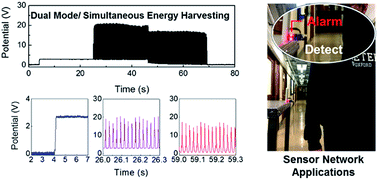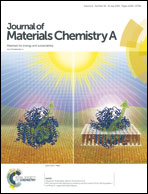Sustainable hybrid energy harvester based on air stable quantum dot solar cells and triboelectric nanogenerator†
Abstract
Realization of self-powered sensor systems is the key to accomplish internet of things technology for smart life of humans. Recent advances in energy harvesting using photovoltaic and triboelectric effects demonstrate outstanding performances of energy harvesters as power supplies. However, there are still fundamental issues that need to be thoroughly dealt with, which have been neglected so far, such as power interruption due to intermittence of environmental energy and long-term device stability in air. In this report, we demonstrate a hybrid energy harvester (HEH) that is composed of high air stable quantum dots solar cells (QDSCs) and a triboelectric nanogenerator (TENG). The HEH demonstrates dual mode as well as simultaneous energy harvesting with respect to types of energy present. Attributed to high photocurrent and high potential from QDSCs and the TENG, immediate base power followed by steady enhancement in power generation is achieved in this hybrid system. The HEH demonstrates as a stable power supply to accomplish a sustainable sensor system without the aid of any external power supply.



 Please wait while we load your content...
Please wait while we load your content...